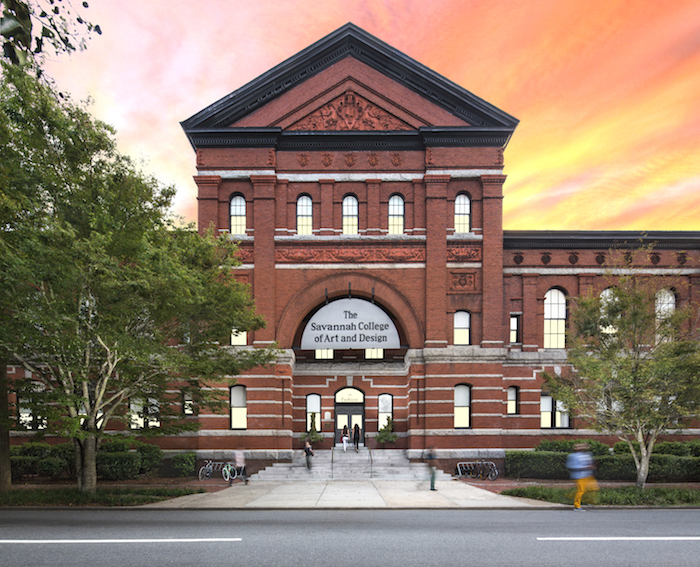
SCAD's Eckburg Hall
This week Design Observer has the pleasure of excerpting from the memoir of Savannah College of Art and Design President and Founder Paula Wallace. The Bee and the Acorn weaves together personal memoir, institutional evolution, and the urban history of Savannah. Wallace recalls the challenges and the discoveries made, the luck and good will rendered, and the reward in perseverance.
Established in 1978, the Savannah College of Art and Design is a private, nonprofit, accredited university, offering more than 100 academic degree programs in forty-two majors in Atlanta and Savannah, Hong Kong, and Lacoste, France. The university s innovative curriculum is enhanced by professional-level technology, equipment, and learning resources, as well as opportunities for internships, professional certifications, and collaborative projects with corporate partners.
The Bee and the Acorn traces the journey of Wallace and her family to the historic Georgia coastal town of Savannah, where they set about creating a new university for the arts. The tiny college would be a radically different kind of institution, buzzing with progressive ideas about what education could be and what it should do for students. Nearly forty years later, SCAD has become one of the largest and most highly regarded arts universities in the world.
See Part 1 here and part 2 here.
++++
It was easy to love elementary school students, of course—students who were quick with hugs and who needed help tying their shoes—but SCAD students were just as precious, in many ways just as earnest, creative, and open to all the beauty and possibility around them. In them I saw the glorious paradox of the young artist. They were confident, competent, professional, but also vulnerable, sharing their fears and hopes with the world.
I wanted to provide an environment where students could learn to be resilient, hardworking professionals, but also an environment that was nurturing, where students were treated with kindness. That meant finding more great teachers and keeping them. One idea I had early on was to award fellowships to fac-ulty members who had creative or research projects. Another idea was to make individualized help sessions a requirement in every class, to help prepare students for midterms, final projects, client presentations.
I wrote these ideas everywhere, and my staff found them in odd places, tucked between the pages of books, underneath teacups.
“Is this a note, or just scribbling?” they’d ask. “Both?” I’d say.
“This one says something about trees and light.” “Maybe we need more trees,” I said.
“Maybe you were sleep-writing again.” “I was dreaming of cypresses.”
“Do you want us to plant trees?” “Van Gogh’s cypresses.”
“You want us to plant van Gogh’s cypresses?” “I want to take students to see them,” I said.
I scribbled everything on the backs of paper tea doilies, many of which I still have, notes about how to grow our new film festival (screenwriting competition, master classes), ideas for showcasing the design disciplines (SCAD fashion week? Design week? Style week?), ideas for new degree programs (designing objects—cars, toys, something on the computer/online—ask students). I still have many of these notes. They remind me that big accomplishments grow from small ideas.
++++
At some point during my tours with guests, the conversation always turns to one unmistakable fact: Art is everywhere, in meet- ing rooms, classrooms, even restrooms. “This must be a gallery,” they say, of this or that random hallway. “No, the gallery’s just up ahead.”
This level of art saturation is rare, I think, even for an art and design university. It’s not just because we love beauty, I explain to guests. The intentional placement of thousands of works of art in direct proximity to students is a strategic decision, another distinguishing factor of SCAD. Students are immersed in art and observe quality, just by walking around every SCAD campus.
Our mission is to prepare students for professional careers, and one way we do that is by purchasing a great deal of student and alumni art every year. Students benefit tremendously from this process, learning how to price their work, how to prepare it for sale, transport it, deliver it. And when they see it on display somewhere around the university, the pride on their faces is unmistakable.
At last count, the SCAD Permanent Collection included 11,376 works of art created by literally thousands of students, faculty, and alumni. As I write this, nearly 6000 of those works are hanging somewhere at SCAD facilities in Savannah, Atlanta, Lacoste, or Hong Kong. This number doesn’t include the collections at the SCAD Museum of Art—an estimated 5000 pieces—or work in the dozens of university galleries on three continents, where, in the past academic year, we hosted more than sixty exhibitions.
These days, when visitors assume this or that hallway is a gallery, I don’t disabuse them.
They’re right. It is.
